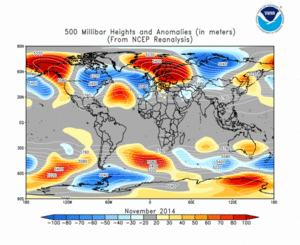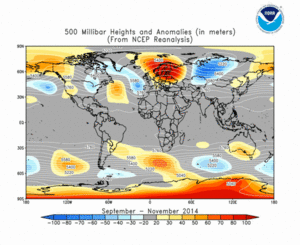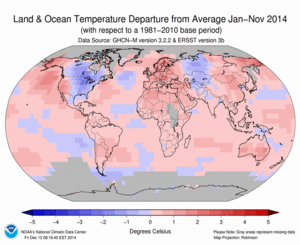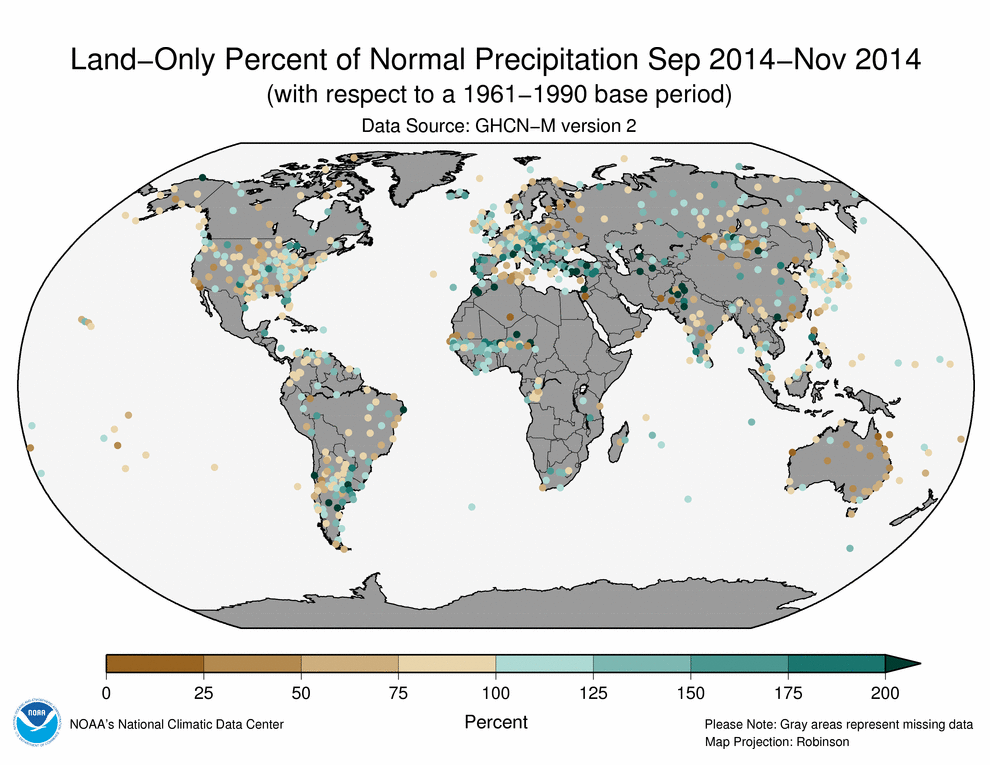Global Highlights
- The combined average temperature over global land and ocean surfaces for November 2014 tied with 2008 as seventh highest in the 135-year period of record, at 0.65°C (1.17°F) above the 20th century average of 12.9°C (55.2°F).
- The global land surface temperature was 0.82°C (1.48°F) above the 20th century average of 5.9°C (42.6°F), the 13th highest for November on record. For the global oceans, the November average sea surface temperature was 0.59°C (1.06°F) above the 20th century average of 15.8°C (60.4°F), record high for November.
- The combined global land and ocean average surface temperature for the September–November period was 0.70°C (1.26°F) above the 20th century average of 14.0°C (57.1°F), the warmest such period on record.
- The September–November worldwide land surface temperature was 0.90°C (1.62°F) above the 20th century average, the ninth warmest such period on record. The global ocean surface temperature for the same period was 0.63°C (1.13°F) above the 20th century average, record high for September–November.
- The combined global land and ocean average surface temperature for the year-to-date (January–November) was 0.68°C (1.22°F) above the 20th century average of 14.0°C (57.2°F), the warmest such period on record.
Introduction
Temperature anomalies and percentiles are shown on the gridded maps below at the monthly, seasonal (as appropriate), and year-to-date time scales. The anomaly map on the left is a product of a merged land surface temperature (Global Historical Climatology Network, GHCN) and sea surface temperature (ERSST.v3b) anomaly analysis developed by Smith et al. (2008). Temperature anomalies for land and ocean are analyzed separately and then merged to form the global analysis. For more information, please visit NCDC's Global Surface Temperature Anomalies page. The maps on the right are percentile maps that complement the information provided by the anomaly maps. These provide additional information by placing the temperature anomaly observed for a specific place and time period into historical perspective, showing how the most current month, season, or year compares with the past.
The most current data may be accessed via the Global Surface Temperature Anomalies page.
Temperatures
In the atmosphere, 500-millibar height pressure anomalies correlate well with temperatures at the Earth's surface. The average position of the upper-level ridges of high pressure and troughs of low pressure—depicted by positive and negative 500-millibar height anomalies on the  November 2014 and
November 2014 and  September 2014–November 2014 maps—is generally reflected by areas of positive and negative temperature anomalies at the surface, respectively.
September 2014–November 2014 maps—is generally reflected by areas of positive and negative temperature anomalies at the surface, respectively.
November
With records dating back to 1880, the global temperature across the world's land and ocean surfaces for November 2014 was 0.65°C (1.17°F) higher than the 20th century average of 12.9°C (55.2°F), tying with 2008 as the seventh warmest November on record. The 12 warmest Novembers on record have all occurred during the 21st century. Separately, the temperature departure from average for the month was the third highest for the Southern Hemisphere and ninth highest for the Northern Hemisphere.
Globally, the average land surface temperature was the 13th highest on record for November, at 0.82°C (1.48°F) above the 20th century average. As shown by the Land & Ocean Temperature Percentiles map above, warmer-than-average temperatures were evident over much of the global land surfaces. Most of North America, parts of southwest Asia, and a few isolated areas of northern Russia were cooler or much cooler than average.
Select national information is highlighted below. (Please note that different countries report anomalies with respect to different base periods. The information provided here is based directly upon these data):
- The average November maximum temperature for Australia was the highest since records began in 1910, at 2.19°C (3.94°F) above the 1961–1990 average, breaking the previous record set in 2006 and marking the second consecutive month with a record high national maximum temperature. The November minimum temperature was third highest on record, contributing to the record highest November mean temperature for the country, at 1.88°C (3.38°F) above average and beating the previous record set in 2009. The state of Queensland had record high November minimum, maximum, and mean temperatures. New South Wales, South Australia, Western Australia, and the Northern Territory also observed mean November temperatures that ranked among their 10 warmest in the 105-year period of record.
- Austria had its warmest November since national records began in 1767 (248-year period of record), with a temperature 3.8°C (6.8°F) above the 1981–2010 average, beating the previous warmest November of 1926 by 0.4°C (0.7°F).
- Switzerland also observed its warmest November since national records began in 1864, with a monthly temperature 3.3°C (5.9°F) above the 1981–2010 average, surpassing the previous warmest November of 1994. The unusual heat for this time of year brought blooming flowers and ripe strawberries, according to MeteoSwiss.
- November 2014 tied with 1953 as the third warmest November for Denmark since national records began in 1874, behind only 2006 and 1938. The average minimum temperature was record high, while the average maximum temperature was fourth highest on record. Unless December is exceptionally cold, Denmark is on track to list 2014 as its warmest year on record.
- In Norway, November was 2.4°C (4.3°F) warmer than the 1981–2010 average, ranking this month among the 20 warmest Novembers since national records began in 1900. According to Meteorologisk institutt, Østafjells observed temperatures 4–5°C (7–9°F) above average at some locations.
- It was the fifth warmest November for the United Kingdom since national records commenced in 1910. The monthly temperature was 1.4°C (2.5°F) higher than the 1981–2010 average.
Warm southerly winds persisted during November across much of Europe, contributing to especially warm temperatures for this time of year.
The average November temperature for the global oceans was record high for the month, at 0.59°C (1.06°F) above the 20th century average, beating the previous record set in 1997 by 0.03°C (0.05°F). This marks the seventh consecutive month with a record warm monthly global ocean temperature. Record warmth was particularly notable across the eastern Pacific Ocean off the western coast of the United States, sections of the equatorial western Pacific, parts of the western North Atlantic, and the eastern north Atlantic near northwestern Europe extending into regions of the Arctic Seas. NOAA's Climate Prediction Center estimates that there is a 65 percent chance that El Niño will be present during the Northern Hemisphere winter and last into the Northern Hemisphere spring 2015. This forecast focuses on the ocean surface temperatures between 5°N and 5°S latitude and 170°W to 120°W longitude.
| November | Anomaly | Rank (out of 135 years) | Records | ||||
|---|---|---|---|---|---|---|---|
| °C | °F | Year(s) | °C | °F | |||
| Global | |||||||
| Land | +0.82 ± 0.11 | +1.48 ± 0.20 | Warmest | 13th | 2010 | +1.60 | +2.88 |
| Coolest | 123rd | 1892 | -0.94 | -1.69 | |||
| Ocean | +0.59 ± 0.04 | +1.06 ± 0.07 | Warmest | 1st | 2014 | +0.59 | +1.06 |
| Coolest | 135th | 1909 | -0.49 | -0.88 | |||
| Land and Ocean | +0.65 ± 0.07 | +1.17 ± 0.13 | Warmest | 7th | 2013 | +0.78 | +1.40 |
| Coolest | 129th | 1907 | -0.52 | -0.94 | |||
| Ties: 2008 | |||||||
| Northern Hemisphere | |||||||
| Land | +0.75 ± 0.13 | +1.35 ± 0.23 | Warmest | 16th | 2010 | +2.02 | +3.64 |
| Coolest | 120th | 1892 | -1.19 | -2.14 | |||
| Ties: 1980 | |||||||
| Ocean | +0.70 ± 0.06 | +1.26 ± 0.11 | Warmest | 1st | 2014 | +0.70 | +1.26 |
| Coolest | 135th | 1909, 1912 | -0.52 | -0.94 | |||
| Land and Ocean | +0.72 ± 0.08 | +1.30 ± 0.14 | Warmest | 9th | 2010 | +1.04 | +1.87 |
| Coolest | 127th | 1892 | -0.73 | -1.31 | |||
| Southern Hemisphere | |||||||
| Land | +0.98 ± 0.12 | +1.76 ± 0.22 | Warmest | 3rd | 2009 | +1.16 | +2.09 |
| Coolest | 133rd | 1917 | -0.77 | -1.39 | |||
| Ocean | +0.52 ± 0.04 | +0.94 ± 0.07 | Warmest | 3rd | 1997 | +0.57 | +1.03 |
| Coolest | 133rd | 1910 | -0.45 | -0.81 | |||
| Ties: 2013 | |||||||
| Land and Ocean | +0.59 ± 0.06 | +1.06 ± 0.11 | Warmest | 3rd | 2009 | +0.64 | +1.15 |
| Coolest | 133rd | 1910 | -0.49 | -0.88 | |||
| Arctic | |||||||
| Land and Ocean | +1.29 ± 0.67 | +2.32 ± 1.21 | Warmest | 16th | 2010 | +2.38 | +4.28 |
| Coolest | 120th | 1902 | -2.44 | -4.39 | |||
The most current data November be accessed via the Global Surface Temperature Anomalies page.
Seasonal (September–November)
September–November 2014, at 0.70°C (1.26°F) higher than the 20th century average, was the warmest such period across global land and ocean surfaces since record keeping began in 1880, edging out the previous record set in 2005 by 0.01°C (0.02°F). The global ocean temperature was a major contributor to the global average, as its departure from average for the period was also highest on record, at 0.63°C (1.13°F) above average, 0.06°C (0.11°F) higher than the previous record set back in 2003. September, October, and November were all record warm for the ocean surfaces. The average temperature across land surfaces was the ninth highest for September–November. Regionally, the Southern Hemisphere temperature across land and oceans combined was also record high for its spring season, while the Northern Hemisphere temperature was fourth highest for its fall season.
Select national information is highlighted below. (Please note that different countries report anomalies with respect to different base periods. The information provided here is based directly upon these data):
- For the second year in a row, Australia observed its warmest spring (September–November) in the country's 105-year period of record, at 1.67°C (3.01°F) higher than the 1961–1990 average temperature. This breaks the previous record, set in 2013, by 0.10°C (0.18°F). The average minimum temperature for the season tied as the fifth highest on record for the country, while the maximum temperature was record high, easily surpassing the previous record of 2013 by 0.27°C (0.49°F). The warmth was seen across the country, with every state and territory reporting a mean temperature among their 10 highest on record; South Australia and Western Australia were each record warm. According to the Bureau of Meteorology, nine of the ten warmest summers on record have occurred since 2002.
- With September, October, and November all more than 1°C (1.8°F) above average, the United Kingdom had its third warmest fall in the 105-year period of record, at 1.4°C (2.5°F) higher than the 1981–2010 average. Only the falls of 2006 and 2011 were warmer, according to the UK Met Office.
- The seventh warmest October and record warmest November contributed to Austria's warmest fall (September–November) since national records began in 1767, at 2.2°C (4.0°F) above the 1981–2010 average. This temperature surpassed the previous record warm fall of 2006 by 0.2°C (0.4°F). Some regions of the country had no fall frost for the first time since records began. In total, 47 stations reported no freezing temperatures during this period (39 stations for the first time in their history); the first frost days typically occur in October across most of Austria, according to ZAMG.
- Germany observed its second warmest fall since national records began in in the country's 134-year period of record, with a temperature 2.3°C (4.1°F) higher than the 1961–1990 average and 2.1°C (3.8°F) higher than the more recent 1981–2010 average. Only fall of 2006 was warmer.
- Switzerland also observed its second warmest fall in the country's 151-year period of record, cooler only than fall 2006, with a temperature 2.2°C (4.0°F) higher than the 1981–2010 average.
- Denmark too had its second warmest fall since records began in 1874, also cooler only than fall 2006. The average minimum temperature for the season was second highest on record while the average maximum temperature tied with 2005 as third highest.
- And with national records dating back to 1900, France also had its second warmest fall behind 2006, at 2.3°C (4.1°F) higher than its 1981–2010 average temperature. Several localized regions were record warm for the season.
| September–November | Anomaly | Rank (out of 135 years) | Records | ||||
|---|---|---|---|---|---|---|---|
| °C | °F | Year(s) | °C | °F | |||
| Global | |||||||
| Land | +0.90 ± 0.17 | +1.62 ± 0.31 | Warmest | 9th | 2005 | +1.20 | +2.16 |
| Coolest | 127th | 1912 | -0.77 | -1.39 | |||
| Ocean | +0.63 ± 0.04 | +1.13 ± 0.07 | Warmest | 1st | 2014 | +0.63 | +1.13 |
| Coolest | 135th | 1909 | -0.46 | -0.83 | |||
| Land and Ocean | +0.70 ± 0.09 | +1.26 ± 0.16 | Warmest | 1st | 2014 | +0.70 | +1.26 |
| Coolest | 135th | 1912 | -0.52 | -0.94 | |||
| Northern Hemisphere | |||||||
| Land | +0.79 ± 0.18 | +1.42 ± 0.32 | Warmest | 13th | 2005 | +1.35 | +2.43 |
| Coolest | 123rd | 1912 | -0.97 | -1.75 | |||
| Ocean | +0.76 ± 0.05 | +1.37 ± 0.09 | Warmest | 1st | 2014 | +0.76 | +1.37 |
| Coolest | 135th | 1912 | -0.53 | -0.95 | |||
| Land and Ocean | +0.77 ± 0.12 | +1.39 ± 0.22 | Warmest | 4th | 2005 | +0.87 | +1.57 |
| Coolest | 132nd | 1912 | -0.69 | -1.24 | |||
| Southern Hemisphere | |||||||
| Land | +1.19 ± 0.15 | +2.14 ± 0.27 | Warmest | 1st | 2014 | +1.19 | +2.14 |
| Coolest | 135th | 1910 | -0.54 | -0.97 | |||
| Ocean | +0.53 ± 0.04 | +0.95 ± 0.07 | Warmest | 2nd | 1997 | +0.58 | +1.04 |
| Coolest | 134th | 1908, 1910 | -0.43 | -0.77 | |||
| Land and Ocean | +0.64 ± 0.07 | +1.15 ± 0.13 | Warmest | 1st | 2014 | +0.64 | +1.15 |
| Coolest | 135th | 1910 | -0.45 | -0.81 | |||
| Arctic | |||||||
| Land and Ocean | +0.89 ± 0.32 | +1.60 ± 0.58 | Warmest | 14th | 2005 | +1.64 | +2.95 |
| Coolest | 122nd | 1902 | -1.36 | -2.45 | |||
| Ties: 1947 | |||||||
The most current data November be accessed via the Global Surface Temperature Anomalies page.
Year-to-date (January–November)
The first 11 months of 2014 (January–November) was the warmest such period on record across the world's land and ocean surfaces, with an average temperature that was 0.68°C (1.22°F) above the 20th century average. If December is at least 0.42°C (0.76°F) higher than its 20th century average, 2014 will surpass 2005 and 2010 as the warmest year on record.
The average global sea surface temperature was the highest for January–November in the 135-year period of record, due in large part to seven consecutive months (May–November) of record warmth. The average land surface temperature for the year-to-date was the sixth highest, with 9 of 11 months ranking among the 10 highest for their respective month.
| January–November | Anomaly | Rank (out of 135 years) | Records | ||||
|---|---|---|---|---|---|---|---|
| °C | °F | Year(s) | °C | °F | |||
| Global | |||||||
| Land | +0.95 ± 0.21 | +1.71 ± 0.38 | Warmest | 6th | 2010 | +1.09 | +1.96 |
| Coolest | 130th | 1884 | -0.61 | -1.10 | |||
| Ocean | +0.57 ± 0.04 | +1.03 ± 0.07 | Warmest | 1st | 2014 | +0.57 | +1.03 |
| Coolest | 135th | 1911 | -0.46 | -0.83 | |||
| Land and Ocean | +0.68 ± 0.10 | +1.22 ± 0.18 | Warmest | 1st | 2014 | +0.68 | +1.22 |
| Coolest | 135th | 1911 | -0.46 | -0.83 | |||
| Northern Hemisphere | |||||||
| Land | +0.97 ± 0.26 | +1.75 ± 0.47 | Warmest | 7th | 2007 | +1.22 | +2.20 |
| Coolest | 129th | 1884 | -0.72 | -1.30 | |||
| Ocean | +0.65 ± 0.06 | +1.17 ± 0.11 | Warmest | 1st | 2014 | +0.65 | +1.17 |
| Coolest | 135th | 1910 | -0.47 | -0.85 | |||
| Land and Ocean | +0.77 ± 0.16 | +1.39 ± 0.29 | Warmest | 2nd | 2010 | +0.79 | +1.42 |
| Coolest | 134th | 1912 | -0.47 | -0.85 | |||
| Southern Hemisphere | |||||||
| Land | +0.90 ± 0.12 | +1.62 ± 0.22 | Warmest | 2nd | 2005 | +0.91 | +1.64 |
| Coolest | 134th | 1917 | -0.67 | -1.21 | |||
| Ocean | +0.52 ± 0.04 | +0.94 ± 0.07 | Warmest | 3rd | 1998 | +0.56 | +1.01 |
| Coolest | 133rd | 1911 | -0.49 | -0.88 | |||
| Ties: 2002 | |||||||
| Land and Ocean | +0.58 ± 0.07 | +1.04 ± 0.13 | Warmest | 2nd | 1998 | +0.60 | +1.08 |
| Coolest | 134th | 1911 | -0.49 | -0.88 | |||
| Arctic | |||||||
| Land and Ocean | +1.23 ± 0.19 | +2.21 ± 0.34 | Warmest | 5th | 2007 | +1.42 | +2.56 |
| Coolest | 131st | 1902 | -1.21 | -2.18 | |||
The most current data November be accessed via the Global Surface Temperature Anomalies page.
Precipitation
November
The maps below represent precipitation percent of normal (left) and precipitation percentiles (right) based on the GHCN dataset of land surface stations using a base period of 1961–1990. As is typical, November precipitation anomalies varied significantly around the world. As indicated by the November precipitation percentiles map below, extreme wetness was observed during November across a region of northwestern Algeri, and parts of southern Europe. Extreme dryness was observed in part of the southwestern United States, parts of China and central Mongolia, part of southeastern Pakistan, and the southern Philippines.
Select national information is highlighted below. (Please note that different countries report anomalies with respect to different base periods. The information provided here is based directly upon these data):
- Early winter storms left nearly all of Canada and more than half (50.4 percent) of the United States covered with snow at its peak on November 17. This was the second largest November snow cover extent for Canada, falling shy of the record set just last year.
- A "Medicane" (a portmanteau of "Mediterranean" and "hurricane", referring to its several similarities to a tropical storm), named Qendresa, formed east of Tunisia and impacted parts of the Mediterranean on November 7–8, bringing heavy rain and flooding to the region.
- Spain reported its wettest November since 1997, at 180 percent of average November precipitation.
Seasonal (September–November)
References
- Peterson, T.C. and R.S. Vose, 1997: An Overview of the Global Historical Climatology Network Database. Bull. Amer. Meteorol. Soc., 78, 2837-2849.
- Quayle, R.G., T.C. Peterson, A.N. Basist, and C. S. Godfrey, 1999: An operational near-real-time global temperature index. Geophys. Res. Lett., 26, 333-335.
- Smith, T.M. and R.W. Reynolds, 2005: A global merged land air and sea surface temperature reconstruction based on historical observations (1880-1997), J. Clim., 18, 2021-2036.
- Smith et al., 2008, Improvements to NOAA's Historical Merged Land-Ocean Surface Temperature Analysis (1880-2006), J. Climate., 21, 2283-2293.
 NOAA's National Centers for Environmental Information
NOAA's National Centers for Environmental Information
















